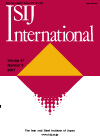Volume 49, Issue 11
Displaying 1-27 of 27 articles from this issue
- |<
- <
- 1
- >
- >|
Fundamentals of High Temperature Processes
Regular Article
-
Article type: Regular Article
Subject area: Fundamentals of High Temperature Processes
2009 Volume 49 Issue 11 Pages 1649-1655
Published: November 15, 2009
Released on J-STAGE: November 18, 2009
Download PDF (541K) -
Article type: Regular Article
Subject area: Fundamentals of High Temperature Processes
2009 Volume 49 Issue 11 Pages 1656-1660
Published: November 15, 2009
Released on J-STAGE: November 18, 2009
Download PDF (303K) -
Article type: Regular Article
Subject area: Fundamentals of High Temperature Processes
2009 Volume 49 Issue 11 Pages 1661-1667
Published: November 15, 2009
Released on J-STAGE: November 18, 2009
Download PDF (2085K) -
Article type: Regular Article
Subject area: Fundamentals of High Temperature Processes
2009 Volume 49 Issue 11 Pages 1668-1672
Published: November 15, 2009
Released on J-STAGE: November 18, 2009
Download PDF (321K) -
Article type: Regular Article
Subject area: Fundamentals of High Temperature Processes
2009 Volume 49 Issue 11 Pages 1673-1677
Published: November 15, 2009
Released on J-STAGE: November 18, 2009
Download PDF (192K) -
Article type: Regular Article
Subject area: Fundamentals of High Temperature Processes
2009 Volume 49 Issue 11 Pages 1678-1685
Published: November 15, 2009
Released on J-STAGE: November 18, 2009
Download PDF (2929K)
Note
-
Article type: Note
Subject area: Fundamentals of High Temperature Processes
2009 Volume 49 Issue 11 Pages 1814-1815
Published: November 15, 2009
Released on J-STAGE: November 18, 2009
Download PDF (402K)
Ironmaking
Regular Article
-
Article type: Regular Article
Subject area: Ironmaking
2009 Volume 49 Issue 11 Pages 1686-1693
Published: November 15, 2009
Released on J-STAGE: November 18, 2009
Download PDF (2403K)
Note
-
Article type: Note
Subject area: Ironmaking
2009 Volume 49 Issue 11 Pages 1816-1818
Published: November 15, 2009
Released on J-STAGE: November 18, 2009
Download PDF (361K)
Steelmaking
Regular Article
-
Article type: Regular Article
Subject area: Steelmaking
2009 Volume 49 Issue 11 Pages 1694-1699
Published: November 15, 2009
Released on J-STAGE: November 18, 2009
Download PDF (483K)
Casting and Solidification
Regular Article
-
Article type: Regular Article
Subject area: Casting and Solidification
2009 Volume 49 Issue 11 Pages 1700-1709
Published: November 15, 2009
Released on J-STAGE: November 18, 2009
Download PDF (4635K) -
Article type: Regular Article
Subject area: Casting and Solidification
2009 Volume 49 Issue 11 Pages 1710-1714
Published: November 15, 2009
Released on J-STAGE: November 18, 2009
Download PDF (297K) -
Article type: Regular Article
Subject area: Casting and Solidification
2009 Volume 49 Issue 11 Pages 1715-1721
Published: November 15, 2009
Released on J-STAGE: November 18, 2009
Download PDF (1024K) -
Article type: Regular Article
Subject area: Casting and Solidification
2009 Volume 49 Issue 11 Pages 1722-1729
Published: November 15, 2009
Released on J-STAGE: November 18, 2009
Download PDF (1244K)
Chemical and Physical Analysis
Regular Article
-
Article type: Regular Article
Subject area: Chemical and Physical Analysis
2009 Volume 49 Issue 11 Pages 1730-1735
Published: November 15, 2009
Released on J-STAGE: November 18, 2009
Download PDF (658K)
Forming Processing and Thermomechanical Treatment
Regular Article
-
Article type: Regular Article
Subject area: Forming Processing and Thermomechanical Treatment
2009 Volume 49 Issue 11 Pages 1736-1743
Published: November 15, 2009
Released on J-STAGE: November 18, 2009
Download PDF (1492K)
Welding and Joining
Regular Article
-
Article type: Regular Article
Subject area: Welding and Joining
2009 Volume 49 Issue 11 Pages 1744-1748
Published: November 15, 2009
Released on J-STAGE: November 18, 2009
Download PDF (2807K) -
Article type: Regular Article
Subject area: Welding and Joining
2009 Volume 49 Issue 11 Pages 1749-1754
Published: November 15, 2009
Released on J-STAGE: November 18, 2009
Download PDF (2632K)
Surface Treatment and Corrosion
Regular Article
-
Article type: Regular Article
Subject area: Surface Treatment and Corrosion
2009 Volume 49 Issue 11 Pages 1755-1761
Published: November 15, 2009
Released on J-STAGE: November 18, 2009
Download PDF (1487K) -
Article type: Regular Article
Subject area: Surface Treatment and Corrosion
2009 Volume 49 Issue 11 Pages 1762-1768
Published: November 15, 2009
Released on J-STAGE: November 18, 2009
Download PDF (2547K) -
Article type: Regular Article
Subject area: Surface Treatment and Corrosion
2009 Volume 49 Issue 11 Pages 1769-1775
Published: November 15, 2009
Released on J-STAGE: November 18, 2009
Download PDF (2582K) -
Article type: Regular Article
Subject area: Surface Treatment and Corrosion
2009 Volume 49 Issue 11 Pages 1776-1783
Published: November 15, 2009
Released on J-STAGE: November 18, 2009
Download PDF (4555K)
Transformations and Microstructures
Regular Article
-
Article type: Regular Article
Subject area: Transformations and Microstructures
2009 Volume 49 Issue 11 Pages 1784-1791
Published: November 15, 2009
Released on J-STAGE: November 18, 2009
Download PDF (3238K) -
Article type: Regular Article
Subject area: Transformations and Microstructures
2009 Volume 49 Issue 11 Pages 1792-1800
Published: November 15, 2009
Released on J-STAGE: November 18, 2009
Download PDF (6055K) -
Effects of Pre-exsisting Boundaries on Microstructure Obtained by Plasma-nitriding of Fe–18%Cr AlloyArticle type: Regular Article
Subject area: Transformations and Microstructures
2009 Volume 49 Issue 11 Pages 1801-1805
Published: November 15, 2009
Released on J-STAGE: November 18, 2009
Download PDF (5480K)
Mechanical Properties
Regular Article
-
Article type: Regular Article
2009 Volume 49 Issue 11 Pages 1806-1813
Published: November 15, 2009
Released on J-STAGE: November 18, 2009
Download PDF (2649K)
Erratum
-
Article type: Errata
2009 Volume 49 Issue 11 Pages E1
Published: November 15, 2009
Released on J-STAGE: November 18, 2009
Download PDF (19K)
- |<
- <
- 1
- >
- >|
